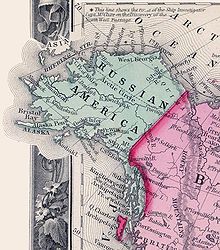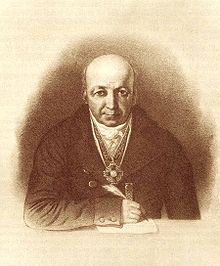Russian America
As Russian America (Русская Америка, Russkaja America), today's Alaska and the Russian possessions in California up to 1841 and 1867 were designated. Alaska's south coast and parts of the Aleutian Islands were discovered by Vitus Bering and Alexei Tschirikow in 1741 , after the Russian Semyon Deshnev had crossed the Bering Strait 93 years earlier . As a monopoly of the Russian-American Company , the country was then owned by Russia before it was ceded to the USA by the Russian Emperor for 7.2 million dollars in 1867 ( Alaska Purchase ).
history
Discovery of Alaska
In 1581 the retired Cossack Ermak Timofeev on behalf of the dealer Dynasty Stroganov going to the Khanate of Sibir to conquer a late remnant of the Great Mongol horde .
Sixty years later, Russian fighters and soldiers reached the shores of the Pacific Ocean . On the shores of the ocean, they learned from their local guide that this is the “Penzhin”, the “Big Water”, behind it lies the mythical “Big Land” - Alaska.
The first European who possibly sighted Alaska was the Russian fur hunter Semyon Deschnjow , who circumnavigated the Chukchi Peninsula in 1648 and thus refuted the thesis that America and Asia are connected. However, his report was not rediscovered in the Yakutsk archives until 1736.
The Dane Vitus Bering , sailing on behalf of the Russian Emperor, failed in his attempt to reach Alaska in 1728 and 1729, but made it during the Great Nordic Expedition in 1741. However, the Russian captain Alexei Tschirikow undertook the first shore leave on July 15 of that year the St. Paul , the second ship of Bering's expedition, south of today's Sitka . Bering reached the coast about 600 km further north the next day - the ships had previously been separated in a storm. On the return voyage, the St. Peter , the Bering ship, had to land on the Bering Island , which was later named after him , where he died on December 19, 1741. The rest of the crew arrived back in August 1742 at the port of departure, today's Petropavlovsk on Kamchatka . The observations of the German botanist and zoologist Georg Wilhelm Steller , who described some American animal and plant species for the first time, including the Steller manatee named after him and now exterminated, were also of importance on this expedition .
Settlement of Alaska and the Russian-American Company
In 1745, four years after the discovery of Alaska, the first Russian fur hunters reached the western Aleutian Islands , including Stepan Gavrilowitsch Glotow , who, after starting out as a fur trader, led three expeditions between 1758 and 1768 to explore the Bering Strait and the coast of Alaska.
But because Alaska was too undeveloped and remote, these ventures were hardly profitable. In 1783 Grigory Ivanovich Shelichov landed on the island of Kodiak with two ships . After attacks by the Koniag Indians, he opened fire on them, killing and wounding many. After ensuring his authority in this way, he established the first permanent settlement in Alaska on what is now Three Saints Bay . In 1792 the settlement was relocated to the place of today's city of Kodiak , which developed into the main trading point for fur from the mainland. After a while, the coexistence of locals and Russians turned out to be halfway harmonious.
The fur-hunting societies led by Schelichow until his death in 1795 were merged with two other societies (1799) by Emperor Paul I to form the Russian-American Company . It received the trade monopoly in North America for twenty years , which in turn could be renewed every 20 years. In this way, following the example of the monopoly society of other colonial states, competition was eliminated and the events in Russian America could proceed more smoothly. The shareholders of the company, which also included members of the Moscow imperial family, were able to make considerable profits after a short time.
Alexander Andrejewitsch Baranow explored the coastal areas south of Kodiak until 1798 and one year later founded a branch about 10 km north of what is now Sitka in order to emphasize Russia's sole claim. After this settlement (Arkhangelsk) was destroyed in an attack by the Tlingit in 1802 , Baranow founded Novo-Arkhangelsk (Ново-Архангельск, New Arkhangelsk), today's Sitka, about 6 km away in 1804. New Arkhangelsk officially became the main administrative center of the territory in 1818. Under Baranov's leadership, schools were built in Russian America, the indigenous people were treated more fairly, and a certain level of comfort made the rough life of the pioneers easier from then on . The business with the sea otter furs, which are very popular in China, was very lucrative (each fur brought in up to € 100 in today's equivalent). In 1806 the emperor granted the company the right to fly its own flag depicting a double-headed eagle.
Nikolai Petrovich Resanov , one of Shelikov's sons-in-law, was making plans to take possession of the entire Pacific coast of North America for Russia. After reaching San Francisco Bay in 1805 , his untimely death two years later and the caution of the Russian Tsar soon put an end to these plans. In 1812 Baranov's deputy, Ivan Kuskow , set up the Fort Ross trading post in California as a necessary supply base rather than a claim to power . In 1816, the German Georg Anton Schäffer , who was in Russian service, failed in his attempt to establish Russia on the Sandwich Islands ( Hawaii ).
End of Russian America
The Russian expansion was observed early on, especially by Spain and Great Britain. Spain laid claim to the entire American Pacific coast. In order to support this claim, King Charles III sent. between 1774 and 1792 several expeditions to explore them. One of two ships of the second expedition reached Alaska in 1775 under Juan Francisco de la Bodega y Quadra, and in 1791 Alessandro Malaspina , who was looking for the Northwest Passage on behalf of the Crown . Ultimately, the Spaniards found the efforts in the North Pacific too costly, especially after the Nootka Sound controversy in 1790, and in 1819 it abandoned its claims. The Spanish heritage is limited to a few place names, including the Malaspina Glacier , Revillagigedo Island and the village of Valdez .
British fur hunters and dealers also increasingly flocked to Alaska. The English Hudson's Bay Company had trading posts in Fort Yukon , on the Stikine River and in Wrangell since the 1830s and later , some of which came about through lease agreements with the Russians. Ultimately, however, these were given up in favor of start-ups further south, particularly in what is now British Columbia .
But the climate, the distances and the European competitors in the North Atlantic also ended the Russian plans. The costs were too high, the benefits too little and anyway Russia had its hands full in Europe. The company's activities were barely profitable and so the Russian government took control of them in 1818 and appointed Ferdinand von Wrangel, a naval officer, as governor.
When Fort Ross was sold to the Swiss-Californian farmer John Sutter for 30,000 piastres in 1841 , the story of Russian America was not over. But the signs of the times were clear: in 1844 the first American settlers crossed the Sierra Nevada . Gold was found at Sutters Mühle in 1848, and the California gold rush began. On September 9, 1850, a Spanish-Mexican province became the 31st US state: California .
Alaska was the only overseas colony for the emerging world power Russia. For more than a century, the North American peninsula was only a very distant country for Russia (hence the original Russian name: Dalni Wostok = Far East), where only a few trappers, fur traders and a few Russian Orthodox missionaries were active. The only way to get there from what was then the Russian capital Saint Petersburg around the Cape of Good Hope or Cape Horn took more than half a year.
Over time, the number of fur animals, especially sea otters, continued to decline. The territory was becoming increasingly difficult for Russia to maintain. The native Indians , especially the Tlingit , repeatedly caused difficulties for the Russians. In order to replenish the treasury after the lost Crimean War , Emperor Alexander II agreed to a contract that his ambassador to the USA, Eduard von Stoeckl , had signed with US Secretary of State William H. Seward in Washington on March 30, 1867 . The Russian Empire then sold Alaska to the United States for $ 7.2 million ( Alaska Purchase ). Scoffers called the acquired land "Seward's ice box". Only in the 20th century, with the discovery of numerous mineral resources , especially oil from the 1960s, the enormous strategic and economic value of the area became apparent.
Missionary work in Russian America plays an important role for the Orthodox Church in America today; Above all, one should mention Herrmann von Alaska , who has been venerated as a saint since 1969 .
bibliography
- Peter Littke: From the tsar's eagle to the stars and stripes. The history of Russian Alaska. Magnus, Essen 2003, ISBN 3-88400-019-5 [Contains a German translation of the sales contracts of Fort Ross 1841 and Alaska 1867].
- Marie de Testa, Antoine Gautier: Le diplomate russe Edouard de Stoeckl (ca 1805–1892) et la cession de l'Alaska aux Etats-Unis. In: Marie de Testa, Antoine Gautier: Drogmans et diplomates européens auprès de la Porte ottomane (= Analecta Isisiana , Volume 71), Éditions ISIS, Istanbul 2003, ISBN 975-428258-7 , pp. 463-469.
- Ilya Vinkovetsky: Russian America. An Overseas Colony of a Continental Empire, 1804–1867 , Oxford University Press, New York 2011, ISBN 978-0-19-539128-2 (Dissertation (Thesis, Ph. D. in History) University of California, Berkeley, Spring 2002 , under the title: Native Americans and the Russian empire, 1804–1867 , two volumes, III, 422 pages, 28 cm, English).
- Viola König (Ed.): Friedrich Heinrich von Kittlitz : "Memories of a trip to Russian America, to Micronesia and through Kamchatka" , reprint of an edition from 1853 (in Fraktur)
- Part 1, Olms-Weidmann, Hildesheim / Zurich / New York, NY 2011, ISBN 978-3-487-14370-5 full text online in the viewer, free of charge table of contents ; Content text
- Part 2, Olms-Weidmann, Hildesheim / Zurich / New York, NY 2011, ISBN 978-3-487-14371-2 full text online in the viewer, free of charge table of contents
Web links
- The Russian-American Treaty on Alaska (English)
- The Russian Church and Native Alaskan Cultures (English)
Individual evidence
- ↑ В. N. Вolgutsev: Морской биографический справочник Дальнего Востока России и русской Америки . Ed .: А. I. Gruzdev. Ussuri Publishing House, Vladivostok 1998, ISBN 5-85832-112-7 , p. 60 (Russian, 232 p., Rusneb.ru [PDF; accessed on July 21, 2020]).


